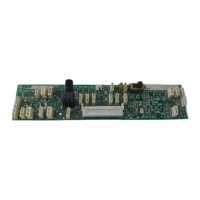9
AMPLUS™ 100 THEORY OF OPERATION
Sheet 2 of 3 (continued)
Finally, the bass boost signal from the dynamic EQ path rejoins the other signals, (the
full range signal, high pass filtered if S4 is in the HP IN position, via S4 and R381, and the
manually adjusted bass boost signal via R4 and U300B) in the summing stage U300A
[C4]. Now, at last, the Ch 1 and Ch 2 signals are ready to enter the power amplifiers, via
connectors J7B [D1] and J8B [B1]. Note that Ch 2 is handled identically by the
companion circuits shown below Ch 1's circuits.
Connectors J7B / J8B send the power amplifier power rails (±20V and ±40V) as well as
±12V power and various grounds. The CLIP / SC signals are returned from the power
amplifiers via these connectors as well.
DC Offset detection circuits
Circuits that watch for excessive DC offsets of the power amplifier outputs are seen at
coordinates C1. Ultimately, these circuits control the operation of relay K600 [sheet 3, B4]
whose contacts enable the ±40V supply relays when K600 is energized. The op amp
circuits U700 and U701 [sheet 2, C2] watch the Ch 1 and Ch 2 power amplifier outputs
for DC offsets greater than about 2.4V. However, in order to keep the relay energized,
other conditions must also be met. The ±40V rails and the ±12V rails must each be within a
certain degree of symmetry. The Ch 1 power amplifier output is low pass filtered to pass
only the DC offset component and is full wave rectified in U700B [C1] and U701A [C2]. A
derived center tap from the ±40V supplies is also brought into the full wave rectifier B600
[sheet 3, B4]. The rectifier output is then compared to -2.4V in U701A [sheet 2, C2] (an op
amp used as a comparator). If the absolute value of the offset is less than 2.4V, U701A's
output is high, which holds Q700 off. Q700 off ensures that Q600 / 601 [sheet 3, B2] can
be on, which allows current to flow through the K600 relay coil, energizing it, and thus
allowing ±40V to be applied to the power amplifiers.
At coordinates [A, B 1, 2] on Sheet 2 of 3, the power amplifier output wiring is detailed.
The power amplifier outputs are always tied to the Ch 1, 2 ± output connector pins,
whether the amplifier mode switch S6 [A2] is in the Bridged or the 2 Channel position.
However, if S6 is in the Bridged position and if a jumper has been placed between the
two XFR CT pins, then the Ch 1 signal and the Ch 2 signals drive the output transformer
primary in concert, potentially delivering in excess of 100 watts to the 70 / 100V output
pins. Jumpers J409, 410 [sheet 2, A1] select between 70V and 100V operation.
Sheet 3 of 3
Refer to the AmPlus 100 schematic diagram, sheet 3 of 3 for the following information.
Sheet 3 outlines the power amplifier and power supply circuits. Channel 1 circuitry is
explained below, Channel 2 operation is identical. The Ch 1 amplifier is built around a
power amplifier IC, U500 [C6], augmented by class G transistors. For U500 audio output
levels between about ±20V, U500 acts on its own, with its power coming from the ±20V
rails via D502 / 509 [C, D5]. When the input signal rises, demanding an output in excess
of about ±20V, transistors Q500, 501, 502 (positive rail) and Q503, 504, 505 (negative
rail) come into play. Each of these transistor trios is driven by the input signal, via steering
diodes D501, 507, and turn on as the higher signal peaks dictate. When Q502 is on, it
handles part of the power dissipation by passing the loudspeaker current through power
devices in series with the U500 rails. This allows U500 to deliver higher voltage, higher
current power to its load while still staying within acceptable IC power dissipation limits.
For those portions of the audio output waveform greater than about ±20V, the class G
power transistors Q502, Q505 dissipate part of the power.

